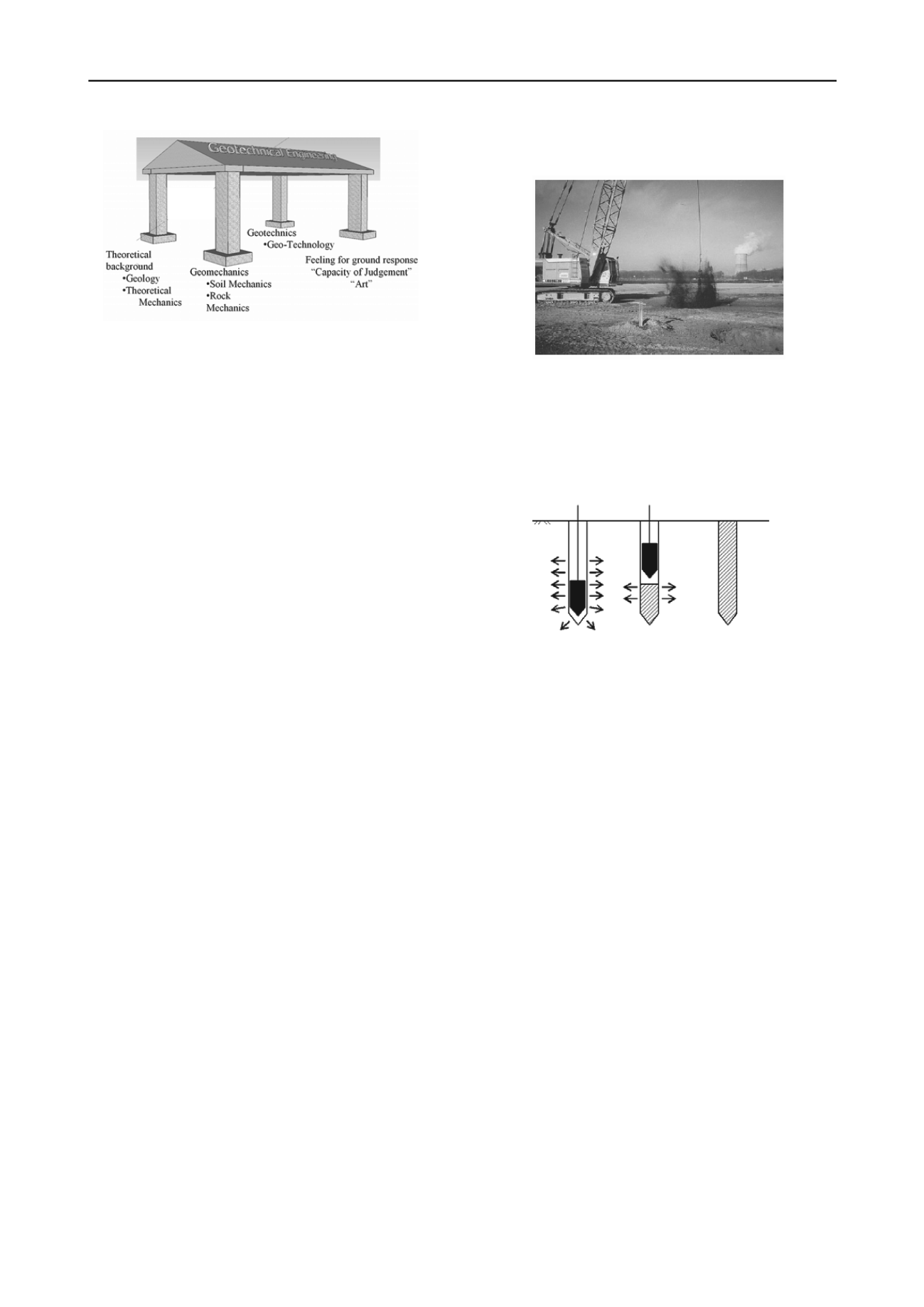
3260
Proceedings of the 18
th
International Conference on Soil Mechanics and Geotechnical Engineering, Paris 2013
Figure 1. Four columns of Geotechnical Engineering
1
ROLE OF ENVIRONMENTAL GEOTECHNICS IN THE
BROWNFIELDS REDEVELOPMENT
Very often the whole process of the brownfields redevelopment
can be divided into the following individual steps, (e.g. Vaníček
and Valenta 2009):
-
site location identification,
-
First phase of investigation,
-
preliminary economic analysis,
-
Second phase of investigation – detailed site analysis
-
project of site development and methods of financing –
feasibility study
-
project and completion of site remediation
-
project and completion of construction of new development
(including foundation engineering, reuse of old foundations).
From these basic 7 steps, it is obvious that environmental
geotechnics is strongly involved in the whole process. But
typical for geotechnical engineers are four parts – 1
st
phase of
investigation, 2
nd
phase of investigation – detailed site analysis,
project and completion of site remediation and the problem of
foundation engineering, respectively reuse of old foundations.
These parts will be discussed further in more detail, (Vaníček
2010).
The first two steps are labelled as the first phase which can
be also called the desk study, which is only supplemented by
visual inspection. So this first phase mostly uses existing
materials, where the study of archive materials and different
maps composes the most important part of this phase.
The 2
nd
phase of the investigation encompasses site
investigation, usually starting with borings, field tests,
collection of samples and laboratory tests. Classical
geotechnical data are useful from the foundation design
perspective, geoenvironmental data from the view of site
contamination.
The properties of the brownfields ground is usually affected
by previous man made activity. These changes have character of
physical, chemical or biological change. Owing to biological
degradation some problems with gas (mostly with methane) are
expected. However in most cases the subsoil remediation is
connected with
Physical improvement of the subsoil quality, with
porosity decrease;
Chemical improvement.
The main principle of physical improvement is to create top
layer with much better quality than subsoil to be able to
eliminate differential settlement of the subsoil and to guarantee
the possibility to create good footing bottom for new
foundations, see more in chapt. 4.
As the depth of the affected subsoil is usually deeper than
the depth for which classical compaction rollers can be used it is
necessary to apply other methods. The dynamic consolidation
method was for example used for the subsoil improvement of
old toxic landfill in Neratovice, (see Figure 2), where on the
compacted material a new landfill was constructed, (e.g.
Vaníček et al 2003).
Fig
g material and subsequently
– International
Co
al approaches, as drilling,
and the horizontal
all regulates the contaminant
a bonding agent to create
nical
problem
connected
with
brownfields
development. This problem is especially sensitive for large
cities as the average design life of office buildings is about fifty
ears.
ure 2. Compaction of deposited waste by dynamic consolidation
In the north part of Bohemia, where there are many inner
spoil heaps composed of uncompacted clay clods, a new method
called “clay piles” was successfully applied.
A pre-driven profile is backfilled by clay of similar
roperties as is the surroundin
p
compacted there, (see Figure 3).
Figure 3. Ground improvement by “clay” piles
The main aim of chemical improvement is to decrease the
degree of subsoil chemical contamination on accepted level.
There is a very wide range of different methods which are
used for site remediation. It is not the intention of this lecture to
present the overview of these methods, because they are
covered elsewhere, (e.g. Suthersan 1997), are summarized by
US EPA or are a part of activities of ICEG
ngresses on Environmental Geotechnics. Most of the
methods utilize some geotechnic
pumping, hydraulic fracturing, and monitoring.
Nevertheless there are 3 methods preferably utilizing
classical geotechnical methods as:
Encapsulation – with the help of the underground sealing
wall (Different types of cut-off walls)
sealing system (CCL – compacted clay liner, GCL –
geosynthetic clay liner, GL – geomembrane liner or
composite liner), (Vaníček et al 1997),
Permeable reactive barrier, e.g. (Jirasko and Vaniček 2009),
where the vertical sealing w
plume to the permeable window –where contaminated water
is cleaned – with the help of sorption, precipitation or
degradation, (see Figure 4).
Stabilization, solidification, - these methods are based on
the principle of mixing waste with
a stiff matrix where the contaminant is bonded. As a
bonding agent the different combinations of cement, ash,
lime and slag are usually applied.
Question about utilization of old foundations is the last
geotech
re
y


